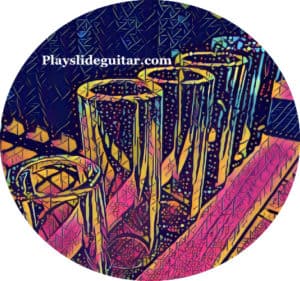As an Amazon Associate Playslideguitar.com earns from qualifying purchases. This page contains affiliate links.
Playing slide guitar is a great way to discover more musical possibilities each time you pick up the guitar. However, most guitarists don’t practice slide guitar consistently because the techniques involved can seem challenging.
There are some great ways to improve your slide guitar playing, and many of them are easy to do in the practice room. Even if you only spend a little bit of practice time on slide guitar, you can easily become proficient in slide playing techniques and find ways to incorporate them into your playing.
Let’s take a look at some of the best ways to practice slide guitar, and how they can also improve your guitar playing…
Develop Your Intonation
One of the most important aspects of slide guitar playing is being able to play in tune. Since you’re not using your fingers to fret notes, when using a slide you often need to be able to play precisely over a fret in order for a note to be in tune.
By developing good intonation, which is another way of referring to this, you’ll gain the ability to quickly and accurately move the slide to various positions on the fretboard. Your ears will be able to tell when a note is slightly out of tune, and you’ll be able to use your muscle memory to move the slide accordingly.
Cello players, and other fretless instrument players, know how important it is to develop good intonation. It is great for the ears, and very important for playing in tune with the other instruments around you.
Practice With A Backing Track
A great way to check your intonation is to listen to the pitches of other instruments and determine if you’re in tune with them. You can use a backing track to do this while in the practice room.
If you’re out of tune, because you’re not placing the slide at the right area over a fret, you’ll be able to hear it. Your notes will have a slight dissonance to them, and it can be hard to make your slide playing sound smooth and fluid.

As you play with a backing track, which usually has a full band that is in tune with each other, try to match your tonality to individual instruments and the whole group. Are you in tune with the bass player?
The bass plays such a foundational role in the music’s harmony and chord changes that it’s a great instrument to calibrate to. Chances are, if you’re playing in tune with the bass player, then you’re in tune with the rest of the group.
Also, be sure to check your intonation with guitar players and keyboardists. Since they make up a large part of the music’s melodic and harmonic elements, it is important that you play in tune with them as much as possible too.
Using Your Ears
By listening critically to yourself, and how you blend in with these individual instruments, you’ll be able to check your intonation with distinct elements of the music that can give you a good indication of how in tune you are. Better yet, the more you calibrate your intonation to individual instruments, the easier it will be to sound in tune with the group as a whole.
Since most listeners aren’t paying attention to the tuning of individual instruments in a song, a group of musicians that sound really in tune with each other will naturally sound more pleasing to people. This is assuming that each instrument is in tune with itself and others, and most musicians nowadays use A=440Hz as a focal tuning note to make sure everyone is in tune with each other.
It’s nearly impossible for an instrument to be perfectly in tune with itself and other instruments (due to the physics of sound and music), however getting these things as close as possible will make the music much more enjoyable to any listener.
Phrasing and Articulation: Making The Most Of Slide Guitar
One of the best things about slide guitar is how expressive it can be for voicing notes. Like the human voice, the slide provides seemingly endless capabilities for phrasing and articulating notes, not to mention how adept it is with creating vibrato.
As you practice, think about the various ways you can slide into a note. Are you sliding into it from one fret below, two frets, or by quickly moving the slide higher up the fretboard?
Even though it is subtle, there can be a big tonal difference between notes that are slid into from one fret below or two frets below.

Often times, sliding into a note from one fret below has a brighter, jazzier feel to it. Sliding from two frets below can have a deeper, bluesier sound that can feel more down to earth.
Also, during more energetic times of a solo or riff, it can be impactful to listeners if you slide way up the fretboard into a note. This can give the note a more thrilling articulation, like a soulful singer that really adds a lot of zest and excitement to certain notes they sing.
Is Your Slide Scraping The Neck Of the Guitar?
It is common and natural for beginner slide guitar players to accidentally scrape the neck of the guitar with the slide as they play. A similar thing can happen when the slide scrapes and touches the surface of the guitar’s fretboard as you play.
An important technique for slide guitar is to be able to make the slide move fluidly and smoothly along the fretboard. This entails being able to sustain notes that you play by putting a certain amount of pressure against the strings, without the slide hitting the neck or fretboard.
Also, when playing slide guitar the strings shouldn’t reach the fretboard either. You’ll easily be able to hear when the slide hits the neck or fretboard because it will make a knocking or scraping sound.
If this happens, fret not! It is natural as you develop your technique on slide guitar to try to find ways to make the slide feel comfortable on your finger (and against the strings) as you play.
The more comfortable and experienced you become with using a slide, the more natural it will be to create a good amount of pressure against the strings with one. This helps with sustain and vibrato, and keeping the slide parallel to the frets is also beneficial for your slide technique.
Practice with Drone Music or Tracks
This is my favorite way to practice intonation for slide guitar, and it also makes practicing slide much more enjoyable. By putting on a drone track, which is essentially a repeating tone or pitch, you can easily dial in your intonation by comparing your playing to the track.
Many cello players, fiddle/violin players, and upright bass players use this practice technique to develop their intonation. It’s very similar to playing with a backing track, however you’re able to focus more on an individual note by one instrument.
Since there are no chord changes with a drone track, and the sound is only being created by a single source or instrument, you can really focus on how in tune your slide playing is with the track. This is a great way to practice scales, phrasing, note articulation, chords, and many other things on slide guitar.
Also, your critical listening and aural skills will naturally develop because this method is good for your ear. By practicing notes and chords over a drone tone, you’re actually hearing what each note sounds like in the context of a harmonic framework.
For instance, instead of just playing a major pentatonic scale with your slide (and listening to how the scale sounds in general) you’ll begin to hear how each individual note sounds in the scale compared to the root note of the scale. You’ll also hear how each note sounds in relation to the other notes in the scale, and learn more about their interval relationships.
An easy way to use a drone track while practicing slide guitar is to pick a note, and then practice a scale over it. For example, if you’re going to practice a G Mixolydian scale, then turn on a G drone track and practice the scale over it. Try to be musical with your playing, and keep a close ear on how in tune each note sounds with the tone.
It can be helpful to set your audio player to repeat the individual track so that you can practice the specific drone note for as long as you’d like. Below are some of my favorite drone music tracks to use for practicing…
Try To Mimic The Human Voice
Another great way to practice slide guitar technique, and further develop your articulation and phrasing of notes as mentioned above, is to find ways to mimic the human voice with your slide.
The slide guitar shares so many emotive qualities with the voice, and this is why so many musicians and listeners are drawn to it. Like a singer’s voice, the slide has a way of captivating people because of how heartfelt and down-to-earth it sounds.
Music accentuates life, and the voice is perhaps the most humanistic musical instrument, which is why it resonates deeply with listeners. Slide guitar has an uncanny ability to create voice-like sounds, and it really adds a lot of feeling to music.
A great way to mimic a singer’s voice is to try to use the slide to make notes scream, cry, smack, quiver, and more. If a human (or singer’s) voice can make a sound, or express an emotion, then there’s a chance that the slide can do the same on your guitar.
Also, create a vibrato with your slide on the guitar that brings out certain emotive qualities from a note. For example, making a note cry can be often be a matter of applying a slow, quivering vibrato as you move the slide along the fretboard.
You can also emulate animal sounds, like making a howling sound or a whale call. There are endless possibilities for slide guitar sounds, and you can even make siren, train, and car sounds.
Conclusion
For anything, the more you practice something the more experience you’ll gain. Slide guitar is no different, but you can use the practice techniques above to make learning and playing easier. Even better, you’ll get more enjoyment out of your practice, which is a great way to approach the challenging slide guitar techniques with ease.
For more playing tips and advice, click here…
